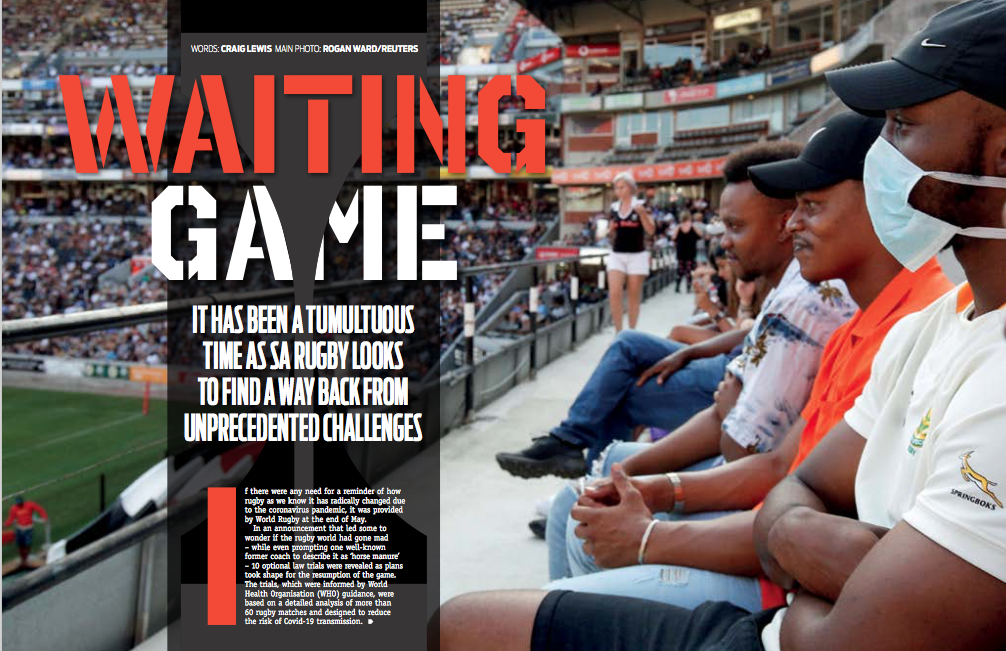SA Rugby is still waiting for the green light from government in order to kick off more comprehensive non-contact training, writes CRAIG LEWIS.
Although 6 July was initially – and hopefully – set as the date for the resumption of training, with franchises having gone through the necessary protocols and checks to ready themselves, the final green light has been somewhat delayed.
It’s hoped that clarification and approval will come from the SA government this week, allowing for limited groups of players to begin conditioning and fitness training in earnest.
The best-case scenario is that a new Currie Cup could be be launched on 29 August, with a final then to take place on 12 December.
READ: New target date for kick-off of local competition
The eight-tournament competition is expected to involve a double round of fixtures, including the four Vodacom Super Rugby teams in addition to the Cheetahs, Kings, Pumas and Griquas.
Indeed, as highlighted in the latest SA Rugby magazine, it has been a tumultuous time as SA rugby looks to find a way back from unprecedented challenges.
In fact, if there were any need for a reminder of how rugby as we know it has radically changed due to the coronavirus pandemic, it was provided by World Rugby at the end of May.
In an announcement that led some to wonder if the rugby world had gone mad – while even prompting one well-known former coach to describe it as ‘horse manure’ – 10 optional law trials were revealed as plans took shape for the resumption of the game. The trials, which were informed by World Health Organisation (WHO) guidance, were based on a detailed analysis of more than 60 rugby matches and designed to reduce the risk of Covid-19 transmission.
Each measure was aimed at reducing cumulative exposure to contact in the scrum, tackle, ruck and maul. The principle behind those ideas may have been sound but they stood in complete contradiction to the very nature of rugby.
As it was, the trials were labelled as ‘optional’, and New Zealand Rugby moved quickly to say it didn’t feel the need for any of these enforcements in their game as Super Rugby Aotearoa neared kick-off in mid-June.
Ultimately, it was all just a sign of the crazy times as rugby sought to find its place when sport began to make a long-awaited move towards restarting.
New Zealand led the way as its Super Rugby teams swept back into action with the virus all but eradicated in that country. Soon after, Australia confirmed it would be able to hold a domestic competition of its own from July. From afar, South Africa looked on …
‘I think that’s fantastic; it’s nice, because it gives us some hope,’ Stormers coach John Dobson said in May when hearing the news of New Zealand’s resumption. But he added another completely understandable sentiment when he smiled and said: ‘We are also as jealous as vipers.’
Mercifully, though, there were signs of hope when South Africa moved to lockdown level three at the start of June, with confirmation from the sports ministry that training for contact sport could resume once all safety protocols were presented and approved.
Competitive action remained out of the question, but as if to evidence these different times, it was confirmed the Stormers, Cape Cobras cricket team and Cape Town City FC would participate in an Esport event, the first in a set of provincial gaming championships.
‘The Covid-19 pandemic has caused the most significant disruption to the worldwide sporting calendar since World War II,’ a statement read. ‘Although some training and leagues have resumed, there is no clear indication of when sport as we know it will return. EsportSA has been working closely with traditional sports brands over the past few months in efforts to pull traditional sports into the digital realm.’
Quite literally, it was all fun and games.
Yet, on the more serious side, it has been an infinitely challenging time for the SA rugby industry as stakeholders sought to cut up to R1.2-billion from the sport’s budget by the end of the year. This was to be achieved principally by the cancellation of competitions (49.7% of savings), cuts in operational budgets (37.3%) and in salary reductions (13%).
The Industry Savings Plan was designed by organisations representing SA Rugby, provincial unions, players and rugby industry employees, while players were given the opportunity to cancel their contracts during a three-week window.
This clause, though, put strain on local franchises as key players became open to overseas offers. In the aftermath of what became known as ‘transfer deadline day’, Sharks CEO Eduard Coetzee said it felt as if he’d gone 12 rounds with legendary boxer Muhammad Ali when World Cup stars such as Lukhanyo Am and Makazole Mapimpi became the target of overseas clubs.
It had also been agreed that the franchises could not engage in counter-offer negotiations or find means to sweeten the deal at a time when as many as 95% of those in the industry had agreed to be ‘all in together’.
‘This has been quite an emotional and difficult time,’ Coetzee said. ‘We told the players that one way or another they’d be doing nothing wrong. It was not like they asked for the escape clause but it was an option offered to them, and then it was up to them how to handle it.’
Of course, there was also the much-publicised wrangle for WP Rugby to retain the services of World Player of the Year Pieter-Steph du Toit. It was confirmed he had exercised the exit clause but he then withdrew his termination notice and accepted the same salary reduction as his teammates, as per the rugby industry’s financial impact plan. Yet, rumours persisted that there was
more to that story.
Elsewhere, the Lions bid farewell to star hooker Malcolm Marx, before confirming they were exploring the legality of his contract cancellation and that they retained hope of keeping him in Johannesburg (ultimately all in vain).
It was messy. It was challenging. And it all served as the backdrop to the unexpected impact of the coronavirus, which has shaken the world to its core.
In an exclusive interview with SA Rugby magazine, MyPlayers CEO Eugene Henning explained the overriding purpose of the industry-wide agreement was to reduce expenditure while also taking into account the possibility of a worst-case scenario where no rugby could be played for the rest of 2020.
‘There was really only one purpose of all the weeks of negotiation and that was to make sure the industry’s cost base was reduced enough to get past this crisis if we don’t play again this year. We can’t achieve that objective if we have exemptions, then you’ll find that you’re not really saving and achieving what you want to. We had a cost-saving number in mind and we had to be all in it together to get there. Everyone has to be treated the same.’
Yet, as the Industry Savings Plan came into effect on 1 May, SA Rugby’s CEO, Jurie Roux, reiterated the focus of the sport had shifted to those return-to-play plans: ‘From the moment we went into lockdown we have been preparing and workshopping internal guidelines and protocols for return to play and to work.’
Besides Roux making an emotive case for a boost to national morale by the sight of the Springboks running out for the first time since winning the World Cup, he reiterated a plan to ensure safety protocols could be capably enforced once it was confirmed training could recommence.
‘This is the news sport has been waiting to hear … We submitted a comprehensive, staged return-to-play protocols document to the department of sport five weeks ago and we are ready to begin medical screening of players immediately. We will seek further clarity from the department on the application of the guidelines as they apply to contact training.
‘But this is an opportunity for our players to enhance their lockdown training regimes by increasing their fitness work for an eventual return to play.’
And so … the waiting game continues …





